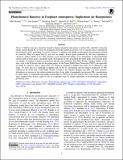| dc.contributor.author | Ranjan, Sukrit | |
| dc.contributor.author | Seager, Sara | |
| dc.contributor.author | Zhan, Zhuchang | |
| dc.contributor.author | Koll, Daniel DB | |
| dc.contributor.author | Bains, William | |
| dc.contributor.author | Petkowski, Janusz J | |
| dc.contributor.author | Huang, Jingcheng | |
| dc.contributor.author | Lin, Zifan | |
| dc.date.accessioned | 2023-03-10T19:37:44Z | |
| dc.date.available | 2023-03-10T19:37:44Z | |
| dc.date.issued | 2022 | |
| dc.identifier.uri | https://hdl.handle.net/1721.1/148484 | |
| dc.description.abstract | About 2.5 billion years ago, microbes learned to harness plentiful solar energy to reduce CO2 with H2O, extracting
energy and producing O2 as waste. O2 production from this metabolic process was so vigorous that it saturated its
photochemical sinks, permitting it to reach “runaway” conditions and rapidly accumulate in the atmosphere despite
its reactivity. Here we argue that O2 may not be unique: diverse gases produced by life may experience a
“runaway” effect similar to O2. This runaway occurs because the ability of an atmosphere to photochemically
cleanse itself of trace gases is generally finite. If produced at rates exceeding this finite limit, even reactive gases
can rapidly accumulate to high concentrations and become potentially detectable. Planets orbiting smaller, cooler
stars, such as the M dwarfs that are the prime targets for the James Webb Space Telescope (JWST), are especially
favorable for runaway, due to their lower UV emission compared to higher-mass stars. As an illustrative case
study, we show that on a habitable exoplanet with an H2–N2 atmosphere and net surface production of NH3
orbiting an M dwarf (the “Cold Haber World” scenario), the reactive biogenic gas NH3 can enter runaway,
whereupon an increase in the surface production flux of one order of magnitude can increase NH3 concentrations
by three orders of magnitude and render it detectable by JWST in just two transits. Our work on this and other
gases suggests that diverse signs of life on exoplanets may be readily detectable at biochemically plausible
production rates. | en_US |
| dc.language.iso | en | |
| dc.publisher | American Astronomical Society | en_US |
| dc.relation.isversionof | 10.3847/1538-4357/AC5749 | en_US |
| dc.rights | Creative Commons Attribution 4.0 International license | en_US |
| dc.rights.uri | https://creativecommons.org/licenses/by/4.0/ | en_US |
| dc.source | The American Astronomical Society | en_US |
| dc.title | Photochemical Runaway in Exoplanet Atmospheres: Implications for Biosignatures | en_US |
| dc.type | Article | en_US |
| dc.identifier.citation | Ranjan, Sukrit, Seager, Sara, Zhan, Zhuchang, Koll, Daniel DB, Bains, William et al. 2022. "Photochemical Runaway in Exoplanet Atmospheres: Implications for Biosignatures." Astrophysical Journal, 930 (2). | |
| dc.contributor.department | Massachusetts Institute of Technology. Department of Earth, Atmospheric, and Planetary Sciences | en_US |
| dc.relation.journal | Astrophysical Journal | en_US |
| dc.eprint.version | Final published version | en_US |
| dc.type.uri | http://purl.org/eprint/type/JournalArticle | en_US |
| eprint.status | http://purl.org/eprint/status/PeerReviewed | en_US |
| dc.date.updated | 2023-03-10T19:30:41Z | |
| dspace.orderedauthors | Ranjan, S; Seager, S; Zhan, Z; Koll, DDB; Bains, W; Petkowski, JJ; Huang, J; Lin, Z | en_US |
| dspace.date.submission | 2023-03-10T19:30:42Z | |
| mit.journal.volume | 930 | en_US |
| mit.journal.issue | 2 | en_US |
| mit.license | PUBLISHER_CC | |
| mit.metadata.status | Authority Work and Publication Information Needed | en_US |
